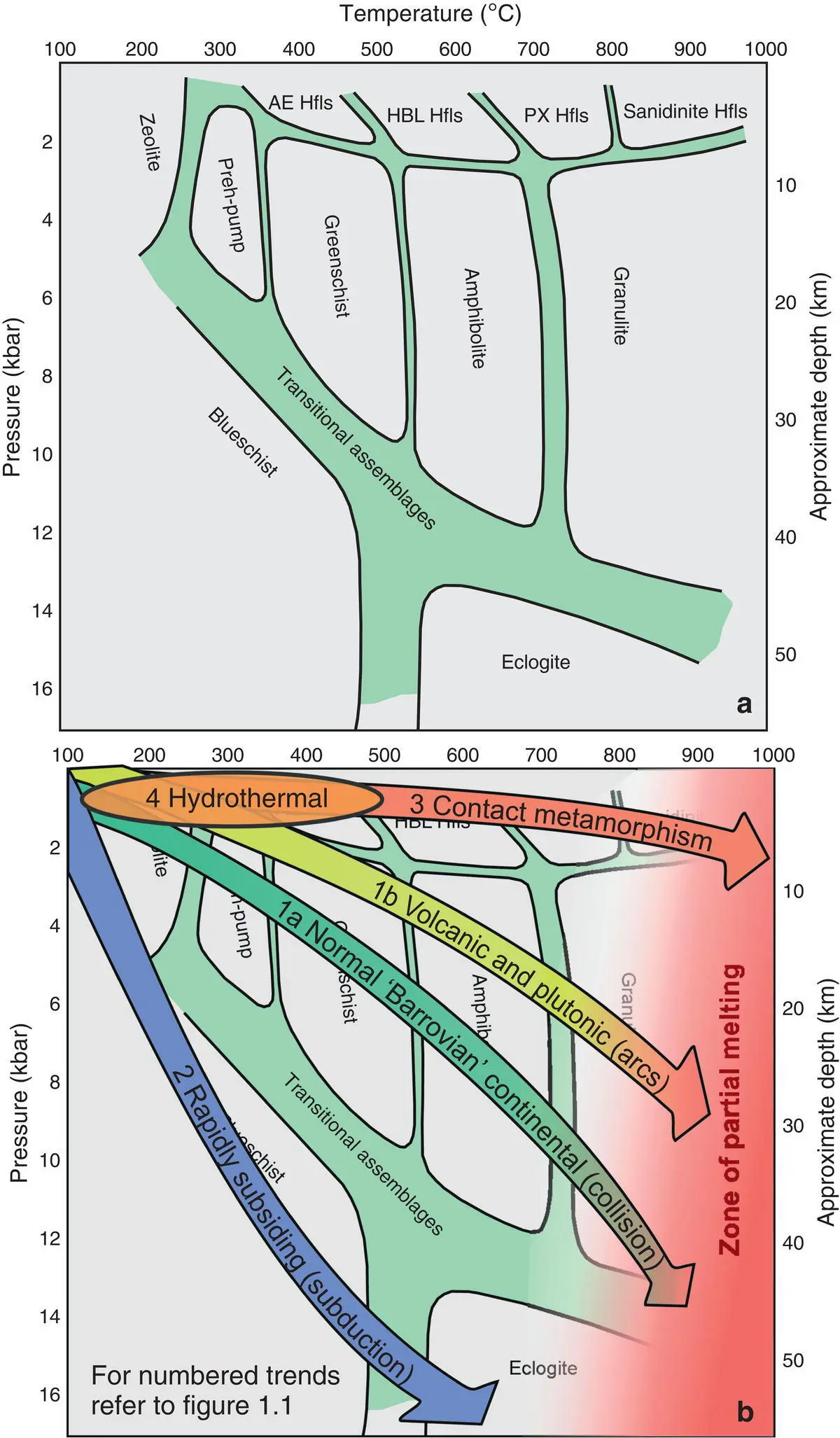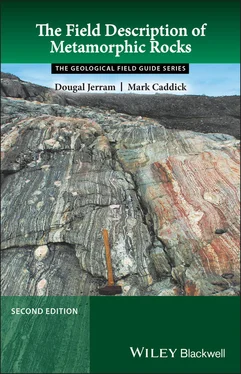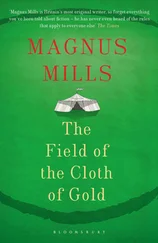Dougal Jerram - The Field Description of Metamorphic Rocks
Здесь есть возможность читать онлайн «Dougal Jerram - The Field Description of Metamorphic Rocks» — ознакомительный отрывок электронной книги совершенно бесплатно, а после прочтения отрывка купить полную версию. В некоторых случаях можно слушать аудио, скачать через торрент в формате fb2 и присутствует краткое содержание. Жанр: unrecognised, на английском языке. Описание произведения, (предисловие) а так же отзывы посетителей доступны на портале библиотеки ЛибКат.
- Название:The Field Description of Metamorphic Rocks
- Автор:
- Жанр:
- Год:неизвестен
- ISBN:нет данных
- Рейтинг книги:4 / 5. Голосов: 1
-
Избранное:Добавить в избранное
- Отзывы:
-
Ваша оценка:
- 80
- 1
- 2
- 3
- 4
- 5
The Field Description of Metamorphic Rocks: краткое содержание, описание и аннотация
Предлагаем к чтению аннотацию, описание, краткое содержание или предисловие (зависит от того, что написал сам автор книги «The Field Description of Metamorphic Rocks»). Если вы не нашли необходимую информацию о книге — напишите в комментариях, мы постараемся отыскать её.
The Field Description of Metamorphic Rocks — читать онлайн ознакомительный отрывок
Ниже представлен текст книги, разбитый по страницам. Система сохранения места последней прочитанной страницы, позволяет с удобством читать онлайн бесплатно книгу «The Field Description of Metamorphic Rocks», без необходимости каждый раз заново искать на чём Вы остановились. Поставьте закладку, и сможете в любой момент перейти на страницу, на которой закончили чтение.
Интервал:
Закладка:
1.3 Mode of Occurrence of Metamorphic Bodies
Because metamorphism is a response of pre‐existing rocks to changes in temperature and pressure, it may be expected that metamorphism is restricted to major zones of deformation in the Earth, such as convergent (destructive) tectonic plate margins. Clearly where major tectonic forces act, such as at subduction/collision zones, the crust undergoes deformation, and rocks will experience changing pressure and temperature upon burial as the crust is thickened. However, metamorphism is not restricted to these environments of the Earth. Extreme temperature changes can be achieved through the contact of molten igneous bodies (sills, dykes, magmas chambers) with country rocks. Also, in certain settings, the wholesale circulation of fluids through the crust can lead to alteration and metamorphism (such as at mid‐ocean ridges). Rocks that are metamorphosed in subduction/collision zones undergo metamorphic changes over broad zones, and can record evidence of passage from one metamorphic grade to another as they journey through different depths. These form the most common types of metamorphic rocks, termed the Regional Metamorphic Rocks. Where rocks are metamorphosed due to contact with hot igneous bodies they are referred to as Contact Metamorphic Rocks. Finally, where alteration and metamorphism occur due to fluids, the rocks are called Hydrothermally Altered Metamorphic Rocks. Some more exotic and rare examples of metamorphic rocks include those specific to fault zones (Cataclastic Metamorphism) occurring as a result of mechanical deformation when two bodies of rock move past one another, and Shock Metamorphism (Impact Metamorphism), where rocks are metamorphosed due to impact from an extraterrestrial body, such as a meteorite or comet.

Figure 1.2 The P/T diagram: (a) the classic fields of metamorphism of mafic rocks (the so‐called matamorphic facies) in P/T space, and (b) the routes that certain tectonic systems take through the P/T space which give rise to different metamorphic rocks. This will be expanded on in more detail in Chapter 3.
1.3.1 Regional metamorphic rocks
The most common of the metamorphic styles, regional metamorphism, occurs in zones defined by key pressure and temperature environments found at certain burial depths in the Earth's crust. The regional metamorphic zones are also restricted by certain tectonic settings that are generally related to subduction and continental collision zones, defining two broad groups of regional metamorphic rocks: those related to mountain building events, where two continents collide, and those formed at subduction zone settings where oceanic crust is subducted. As continent–continent collision is preceded by subduction, both styles of regional metamorphism can sometimes be found in the same location, occasionally with strong evidence of high‐pressure, low‐temperature mineral growth in a subduction zone overprinted by higher temperature mineral growth upon and after collision.
Regional metamorphic zones typically occur due to thickening and/or burial of the crust, so pressure is a very important parameter that drives reactions to progressively change the original rock (protolith) into its different metamorphic types. Certain reactions are strongly pressure‐dependent, and thus the occurrence of specific minerals or mineral assemblages is indicative of ranges of pressure conditions (the most well‐known of which is that diamond typically only forms at pressures greater than the base of normal continental crust). The pressure at which metamorphism occurred is often linked directly with depth, by considering the force applied by the overlying mass of rock. Temperature generally increases with pressure, known as the geothermal gradient (the rate at which temperature increases with depth), but the specifics of this gradient can vary dramatically with tectonic setting. Again, there is generally a mineralogical response to changing temperature, so unravelling the metamorphic history of a series of outcrops in the field can yield important information about the style of regional metamorphism and, thus, tectonic setting and evolution.
A classic study by G. Barrow in the late nineteenth and early twentieth century examined a suite of metamorphic rocks from the Scottish Highlands. The rocks here were formed as part of a mountain building event, the Caledonian orogeny, and show progressively increasing grades of metamorphism depicting the different depths of burial and temperatures attained during the mountain building event. This was unknown at the time of Barrow, whose work was subsequently expanded on by people such as C.E. Tilley in the 1920s, and the concept of exposure of the roots of an ancient mountain belt was yet to be developed. Barrow, however, recognised that specific metamorphic minerals occur in certain groupings, and that the order of their occurrence was predictable (if he walked north in one valley and first found rocks containing garnet, then found rocks containing staurolite, he would be able to find the same succession in a parallel valley several kilometres away). These minerals, termed ‘index minerals’, were thus used to define different zones of metamorphism in the Scottish highlands, and have since been termed the Barrovian sequence. Based on a concept called isograds (planes of constant metamorphic grade), in which the first appearance of a key metamorphic index mineral is mapped, six ‘Barrovian’ zones were thus defined ( Figure 1.3). These will be touched on in more detail in Chapter 3, but can be considered as the background to many of the main metamorphic rocks recognised in un‐roofed collision zones. As such, a systematic view of metamorphism as formulated by Barrow would state that if the protolith was an aluminous sedimentary rock (e.g. a shale) a typical sequence from low to high grade would exhibit the indicator minerals (which are the mapped isograds in Figure 1.3):


Figure 1.3 The classic Barrovian Zones of regional metamorphism first described from Scotland.
This mineralogical change with increasing grade would be mirrored in a maturation of the rock texture as follows:

If the starting material was an igneous rock, such as basalt, the sequence would be:

This is highlighted by the ‘normal continental (collision)’ arrow in Figure 1.2. Examples of low intermediate and high grade regional metamorphic rocks are given in Figure 1.4. Chapter 3provides a more detailed and systematic overview of how rock texture and mineralogy change in rocks of various compositions as metamorphic grade increases.
1.3.2 Subduction zone rocks
In a subduction zone setting (see Figure 1.1), the relatively fast burial of one of the cold plates leaves insufficient time for it to heat up substantially until it is at significant depth. It takes time for the subducted rocks to heat up (generally by conduction from the hotter rocks around them at depth), but application of pressure during burial is instantaneous. Thus in subduction zones the conditions of high pressure – low/moderate temperature metamorphism occur (e.g. the numbered trend 2 in Figure 1.2), and rocks exhumed from these settings record evidence for having been in the blueschist facies. Again, these rocks are characterised by certain indicator minerals and mineral assemblages, and blueschist rocks often appear blue (hence their name) because of the prevalence of a blue amphibole mineral called glaucophane. Exposures of blueschist facies rocks are relatively rare, most obviously because it is difficult to exhume them from the subduction zone to the Earth's surface, but they are an important record of plate tectonics on Earth and will be described in more detail in Chapter 3. An example of a blueschist is given in Figure 1.5a. When the most extreme pressures and moderate to high temperatures are reached, a group of rocks termed the eclogite facies form. Exposure of these on Earth's surface is again relatively rare, but they are generally easily identified, characterised by a pale green pyroxene (sodic rich called omphacite) and a deep red garnet (almandine‐pyrope), an example of which is given in Figure 1.5b (see Chapter 3for more detail).
Читать дальшеИнтервал:
Закладка:
Похожие книги на «The Field Description of Metamorphic Rocks»
Представляем Вашему вниманию похожие книги на «The Field Description of Metamorphic Rocks» списком для выбора. Мы отобрали схожую по названию и смыслу литературу в надежде предоставить читателям больше вариантов отыскать новые, интересные, ещё непрочитанные произведения.
Обсуждение, отзывы о книге «The Field Description of Metamorphic Rocks» и просто собственные мнения читателей. Оставьте ваши комментарии, напишите, что Вы думаете о произведении, его смысле или главных героях. Укажите что конкретно понравилось, а что нет, и почему Вы так считаете.











